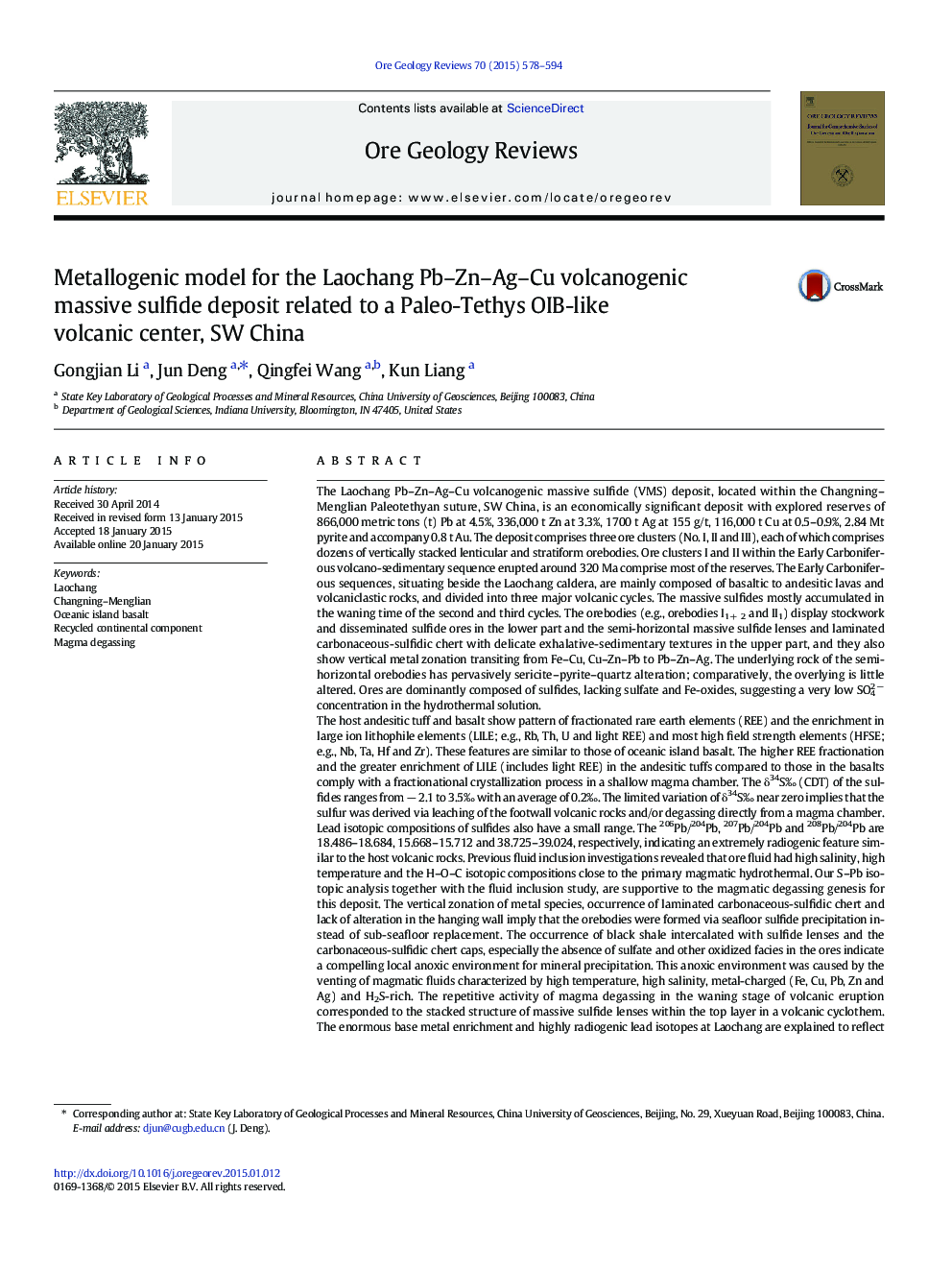| Article ID | Journal | Published Year | Pages | File Type |
|---|---|---|---|---|
| 4696997 | Ore Geology Reviews | 2015 | 17 Pages |
•Laochang is a Mississippian Pb–Zn–Ag–Cu VMS deposit related to a Paleo-Tethys OIB-like volcanic center.•Direct magmatic degassing caused seafloor massive sulfide accumulation and local anoxic environment.•Recycled upper continental crust in the mantle contributed base metals to Laochang deposit.
The Laochang Pb–Zn–Ag–Cu volcanogenic massive sulfide (VMS) deposit, located within the Changning–Menglian Paleotethyan suture, SW China, is an economically significant deposit with explored reserves of 866,000 metric tons (t) Pb at 4.5%, 336,000 t Zn at 3.3%, 1700 t Ag at 155 g/t, 116,000 t Cu at 0.5–0.9%, 2.84 Mt pyrite and accompany 0.8 t Au. The deposit comprises three ore clusters (No. I, II and III), each of which comprises dozens of vertically stacked lenticular and stratiform orebodies. Ore clusters I and II within the Early Carboniferous volcano-sedimentary sequence erupted around 320 Ma comprise most of the reserves. The Early Carboniferous sequences, situating beside the Laochang caldera, are mainly composed of basaltic to andesitic lavas and volcaniclastic rocks, and divided into three major volcanic cycles. The massive sulfides mostly accumulated in the waning time of the second and third cycles. The orebodies (e.g., orebodies I1 + 2 and II1) display stockwork and disseminated sulfide ores in the lower part and the semi-horizontal massive sulfide lenses and laminated carbonaceous-sulfidic chert with delicate exhalative-sedimentary textures in the upper part, and they also show vertical metal zonation transiting from Fe–Cu, Cu–Zn–Pb to Pb–Zn–Ag. The underlying rock of the semi-horizontal orebodies has pervasively sericite–pyrite–quartz alteration; comparatively, the overlying is little altered. Ores are dominantly composed of sulfides, lacking sulfate and Fe-oxides, suggesting a very low SO42 − concentration in the hydrothermal solution.The host andesitic tuff and basalt show pattern of fractionated rare earth elements (REE) and the enrichment in large ion lithophile elements (LILE; e.g., Rb, Th, U and light REE) and most high field strength elements (HFSE; e.g., Nb, Ta, Hf and Zr). These features are similar to those of oceanic island basalt. The higher REE fractionation and the greater enrichment of LILE (includes light REE) in the andesitic tuffs compared to those in the basalts comply with a fractionational crystallization process in a shallow magma chamber. The δ34S‰ (CDT) of the sulfides ranges from − 2.1 to 3.5‰ with an average of 0.2‰. The limited variation of δ34S‰ near zero implies that the sulfur was derived via leaching of the footwall volcanic rocks and/or degassing directly from a magma chamber. Lead isotopic compositions of sulfides also have a small range. The 206Pb/204Pb, 207Pb/204Pb and 208Pb/204Pb are 18.486–18.684, 15.668–15.712 and 38.725–39.024, respectively, indicating an extremely radiogenic feature similar to the host volcanic rocks. Previous fluid inclusion investigations revealed that ore fluid had high salinity, high temperature and the H–O–C isotopic compositions close to the primary magmatic hydrothermal. Our S–Pb isotopic analysis together with the fluid inclusion study, are supportive to the magmatic degassing genesis for this deposit. The vertical zonation of metal species, occurrence of laminated carbonaceous-sulfidic chert and lack of alteration in the hanging wall imply that the orebodies were formed via seafloor sulfide precipitation instead of sub-seafloor replacement. The occurrence of black shale intercalated with sulfide lenses and the carbonaceous-sulfidic chert caps, especially the absence of sulfate and other oxidized facies in the ores indicate a compelling local anoxic environment for mineral precipitation. This anoxic environment was caused by the venting of magmatic fluids characterized by high temperature, high salinity, metal-charged (Fe, Cu, Pb, Zn and Ag) and H2S-rich. The repetitive activity of magma degassing in the waning stage of volcanic eruption corresponded to the stacked structure of massive sulfide lenses within the top layer in a volcanic cyclothem. The enormous base metal enrichment and highly radiogenic lead isotopes at Laochang are explained to reflect the incorporation of a recycled upper continental crust component into the mantle source for the ore-bearing volcanic rocks during the evolution of Tethyan ocean.
Graphical abstractFigure optionsDownload full-size imageDownload as PowerPoint slide
